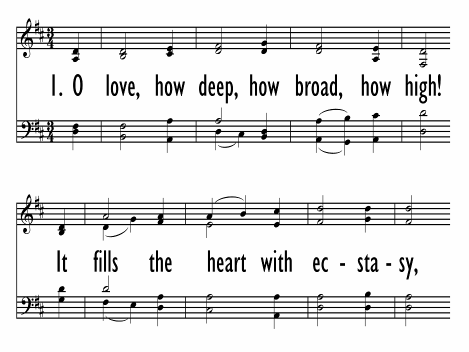- |
User Links
O Love, How Deep, How Broad, How High
Hymn Information
- First Line
- O love, how deep, how broad, how high
- Translator
- Benjamin Webb (1854, alt.)
- Text Source
- Latin, 15th c.
- Tune Name
- DEO GRACIAS
- Harmonizer
- Carl Schalk (1969)
- Tune Source
- English, 15th c.
- Topic
- Church Year: Baptism of Our Lord · Church Year: Easter Vigil · Church Year: Easter/Season of Easter · Powers of Darkness · Doxologies · Jesus Christ: Confidence in · Jesus Christ: Incarnation · Jesus Christ: Love · Jesus Christ: Son of God · Jesus Christ: Teachings of · Trinity
Copyright Information
- Text Copyright
- Public Domain
- Tune Copyright
- © 1969 Concordia Publishing House
- Reprint/Projection Information
- Words: The Words are in the Public Domain; you do not need permission to project or reprint the Words.
- Music: Permitted with a license from CCLI.com or from OneLicense.net. If you do not own one of these licenses, please contact the copyright holder for permission.
Full Text
Scripture References
Thematically related:
- st. 1 = ·
- st. 2 = ·
- st. 3 =
- st. 4 = ·
- st. 5 = · ·
Further Reflections on Scripture References
The text has a wide scope, taking in all of Jesus’ incarnate life: his birth (st. 1); identification with human affairs (st. 2); daily ministry (st. 3); crucifixion (st. 4); resurrection, ascension, and gift of the Spirit (st. 5); the final stanza is a doxology (st. 6). Thus the text summarizes Christ's life in the same manner as the Apostles' Creed. A striking feature is the text's emphasis on the fact that Jesus accomplished all of this "for us"; "for us" occurs at least a dozen times! The redemptive work of Christ is very personally, very corporately applied.
Confessions and Statements of Faith References
Further Reflections on Confessions and Statements of Faith References
There was only one way for the sins of the world to be atoned for—God sent his one and only beloved Son into the world, who took “our mortal form for mortal’s sake” (stanza 1) and was made in “‘human form’, truly assuming a human nature, with all its weaknesses, except for sin...” (Belgic Confession, Article 18).
He was baptized for us, stanza 2 says, and Our World Belongs to God, paragraph 24 assures us that “in his baptism and temptations…Jesus lived a full and righteous human life before us.”
Yet the reason for his coming was to suffer and die for the sins of the world. Stanza 4 captures the process of his suffering and death on the cross. Belgic Confession, Article 21, recounts the many stages of Jesus’ suffering: “…He endured all this for the forgiveness of our sins.” In Heidelberg Catechism, Lord’s Days 15 and 16, Questions and Answers 37-44, there is a more complete description of the significance of his sufferings and death. Our World Belongs to God, paragraph 25, professes that in his suffering and death, “He carried God‘s judgment on our sin—his sacrifice removed our guilt.”
Stanza 5 proclaims: “For us he rose from death again” and the same truth is professed in Our World Belongs to God, paragraph 25, that “God raised him from the dead; he walked out of the grave, conqueror of sin and death—Lord of Life!” Heidelberg Catechism, Lord’s Day 19, Question and Answer 50 explains that he “ascended to heaven to show there that he is head of his church, the one through whom the Father rules all things.” Our World Belongs to God, paragraph 28 says that the ascended Jesus, at Pentecost, “becomes the baptizer, drenching his followers with his Spirit, creating a new community where Father, Son, and Holy Spirit make their home.”
And finally, the song ends in stanza 6 with a doxology to the Trinity. Belgic Confession, Article 8 gives a fuller explanation of all three persons of the Holy Trinity, while Heidelberg Catechism, Lord’s Day 8, Questions and Answers 24 and 25 identifies the primary tasks of each. Our World Belongs to God, paragraph 2 proclaims: “God is King: Let the earth be glad! Christ is victor: his rule has begun! The Spirit is at work: creation is renewed! Hallelujah! Praise the Lord!”
O Love, How Deep, How Broad, How High
Call to Worship
Assurance
Additional Prayers
O Love, How Deep, How Broad, How High
Tune Information
- Name
- DEO GRACIAS
- Key
- c minor
- Meter
- 8.8.8.8


 My Starred Hymns
My Starred Hymns







